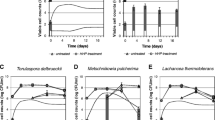Abstract
A heat shock was applied to Saccharomyces cerevisiae: a change from 18°C to 45°C over 5 min and then maintenance at later temperature for 20 min followed by cooling to 18°C. Such a treated inoculum, when used in an alcoholic fermentation of Welsch Riesling grape must at 18°C, gave up to 12 g glycerol l−1 This is a new and easy method for high glycerol production in large scale wine production.


Similar content being viewed by others
References
Attfield PV (1987) Trehalose accumulates in Saccharomyces cerevisiae during exposure to agents that induce heat shock response. FEBS Lett 225:259–263
Bio-Rad (1997) Guide to Aminex HPLC columns for food and beverage analysis. Bio-Rad Publications, Richmond
Carrasco P, Querol A, Del Olmo M (2001) Analysis of the stress resistance of commercial wine yeast strains. Arch Microbiol 175:450–457
Jackson RS (2000) Wine Science: Principles, Practice, Perception., 2nd ed. Academic Press, San Diego
Jesus Torija M, Rozes N, Poblet M, Manuel Guillamon J, Mas A (2003) Effects of fermentation temperature on the population of Saccharomyces cerevisiae. Int Jour Food Microbiol 80:47–53
Karasu Yalcin S, Ozbas Y (2003) Production of glycerol by biochemical routes and its importance in wine fermentations. Gida 28:339–347
Nevoigt E, Stahl U (1997) Osmoregulation and glycerol metabolism in the yeast Saccharomyces cerevisiae. FEMS Microbiol Rev 21:231–241
Nieuwoudt HH, Prior BA, Pretorius IS, Bauer FF (2002) Glycerol in South African table wines:an assessment of its relationship to wine quality. S Afr J Enol Vitic 23:22–30
Nordstrom K (1968) Yeast growth and glycerol formation. II. Carbon and redox balances. J Inst Brew 74:429–432
Odumeru JA, D’Amore T, Russell I, Stewart GG (1992) Changes in protein composition of Saccharomyces brewing strains in response to heat shock and ethanol stress. J Ind Microbial 9:229–234
Omori T, Ogawa K, Umemoto Y, Yuki K, Kajihara Y, Shimoda M, Wada H (1996) Enhancement of glycerol production by brewing yeast Saccharomyces cerevisiae with heat shock treatment. J Ferment Bioeng 82:187–190
Oura E (1977) Reaction products of yeast fermentations. Proc Biochem 12:19–21
Rankine BC, Bridson DA (1971) Glycerol in Australian wines and factors influencing its formation. Am J Enol Vitic 22:2–12
Ribereau-Gayon P, Dubourdieu D, Doneche B, Lonvaud A (2000) Handbook of enology, volume 1. The microbiology of wine and vinifications, Wiley, West Sussex
Roustan JL, Sablayrolles JM (2005) Role of trehalose and glycogen in alcoholic fermentation in wine-making conditions. J Wine Research 15:189–202
Scanes KT, Hohmann S, Prior BA (1998) Glycerol production by yeast Saccharomyces cerevisiae and its relevance to wine. A review. S Afr J Enol Vitic 19:17–24
Author information
Authors and Affiliations
Corresponding author
Rights and permissions
About this article
Cite this article
Berovic, M., Herga, M. Heat shock on Saccharomyces cerevisiae inoculum increases glycerol production in wine fermentation. Biotechnol Lett 29, 891–894 (2007). https://doi.org/10.1007/s10529-007-9337-2
Received:
Revised:
Accepted:
Published:
Issue Date:
DOI: https://doi.org/10.1007/s10529-007-9337-2




